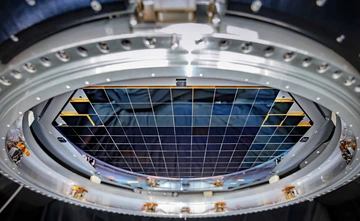U of A astronomers celebrate first look at the universe from the Vera C. Rubin Observatory

The finished mirror for the Vera C. Rubin Observatory's telescope after arriving on site in Chile. Fabricated by the University of Arizona Richard F. Caris Mirror Lab, the mirror spans 27 feet in diameter and acts both as the observatory's primary and tertiary light-collecting surface in one piece, a groundbreaking design approach.
RubinObs/NSF/AURA
Billed as the greatest astronomical discovery machine ever built, the Vera C. Rubin Observatory has released its first imagery: glowing nebulas, pulsating stars, swarms of asteroids and millions of galaxies captured in just 10 hours of test observations. The images offer a striking preview of the observatory's upcoming 10-year Legacy Survey of Space and Time, or LSST.
For the University of Arizona, this moment represents the culmination of decades of vision, collaboration and scientific ingenuity.

A drone view of NSF–DOE Vera C. Rubin Observatory during the First Look observing campaign.
RubinObs/NOIRLab/SLAC/NSF/DOE/AURA/T. Matsopoulos
Built with funding from the National Science Foundation and the U.S. Department of Energy atop Cerro Pachón in Chile – where dry air and dark skies offer unparalleled visibility – the Rubin Observatory features a digital camera as big as a car and a mirror spanning over 27 feet (8.4-meters) in diameter. Fabricated in the U of A's Richard F. Caris Mirror Lab, in the basement of Arizona Stadium, the mirror represents unprecedented engineering by combining both the telescope's primary and tertiary mirror in one piece of glass. An 11-foot (3.4-meter) secondary mirror completes the optical system.
"The Rubin Observatory represents the kind of cutting-edge science that is possible when institutions around the world work together to create a bold future," said University of Arizona President Suresh Garimella. "The extraordinary work of the Richard F. Caris Mirror Lab makes so much possible, and we are proud to have a foundational role in the observatory, and we are equally proud of our faculty who will now help lead the next chapter of discovery."
According to Buddy Martin, a project scientist at the Mirror Lab, the sharp images are a testament to the exceptional quality of the mirrors and the perfect alignment of optics inside the telescope.

A one-of-its-kind design, the combined primary/tertiary mirror rests in its load cell, protected by a blue coating.
Richard F. Caris Mirror Lab/University of Arizona
"All of us at the Mirror Lab are thrilled to see these images, to see this project come to fruition," he said. "Something like this doesn't happen every year, or even every decade, in our line of work."
Unlike other observatories, which typically stare at small patches of sky for long periods of time, the Rubin Observatory will scan the entire southern sky every few nights over the course of the next decade, capturing a high-definition, time-lapse movie of the cosmos. Collecting about 20 terabytes of raw data each night, the telescope will illuminate the forces of dark energy and dark matter and reveal previously unseen interstellar objects. Most importantly, it will catch dynamic processes that elude other telescopes, such as exploding stars and asteroids hurtling across the sky, taking planetary defense efforts to the next level.

More than 120 sensors for the Rubin Observatory were manufactured at the University of Arizona Imaging Technology Laboratory, including half of the CCDs on the main LSST camera, the largest digital camera in the world.
Jacqueline Orrell (SLAC)
From the Rubin Observatory's inception to its scientific impact, U of A researchers have played an instrumental role. Regents Professor Roger Angel, the visionary behind the telescope's optical design, also founded the University of Arizona Richard F. Caris Mirror Lab, where its colossal concentric mirrors were cast and meticulously polished over the course of years. Regents Professor Emeritus Peter Strittmatter and former University President John Schaefer were among the earliest champions of the project, helping establish the LSST Corporation, with U of A as one of its four founding institutions.
For more than 30 years, the U of A has ranked among the top institutions in research expenditures in astronomy and astrophysics, and its expertise is embedded in every layer of the Rubin Observatory's success. For example, nearly half of the imaging sensors for the observatory's digital camera were produced by the Imaging Technology Lab at Steward Observatory, under the leadership of Astronomer Emeritus Michael Lesser.
From the search for the universe's earliest galaxies and quasars to exploring cosmic events like stars being torn apart by black holes, the global research community is preparing to lead a wide range of scientific investigations using Rubin Observatory data. U of A faculty will harness its massive treasure trove of data to unlock the universe's deepest mysteries. The observatory's rich and evolving dataset will also serve as a dynamic platform for training students and postdoctoral researchers, securing Arizona's leadership in astronomy for decades to come.
"This is a transformative era for observational astronomy, and University of Arizona researchers are uniquely positioned to lead the way," said Tomás Díaz de la Rubia, senior vice president for research and partnerships. "Our leadership in this project underscores our commitment to discovery with impact, and our capacity to shape how humanity understands the cosmos. This work exemplifies our mission to tackle the universe's grandest challenges for the public good."





